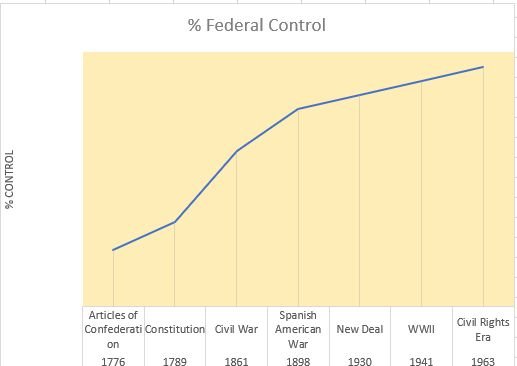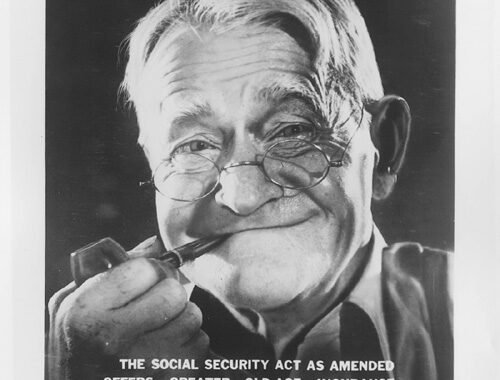
Powershift, Part 1: Overview of the Inflection Points
Abstract: During the course of US history, the balance of power between the states and the federal government shifted to the federal government through a series of inflection points tied to key events.
“The American Republic will endure until the day Congress discovers that it can bribe the public with the public’s money.”
― Alexis de Tocqueville
The series of eight articles is about federal power. It provides an analysis of how the nexus of power moved from the states to the federal government, through Constitutional Amendments, a significant change in the federal bureaucracy and significant new federal programs and activities to include the American Empire after the Spanish American War, The New Deal and the Great Society.
 We now have an immensely powerful federal government that is running amok with deficit spending and is now in the hands of leftists that want to expand its control over all facets of people’s lives. While power itself is amoral, it is a double-ended sword like the blade of El Cid shown in the adjacent figure. If federal power is wielded by people who want to control others and force their ideas upon them through compulsion, it can be, frankly, evil. My operating definition of evil is based on Immanuel Kant’s Categorical Imperative: People are ends in themselves and not means to an end. Treating people as simply means to an end and using them as such is evil. And that is, I suspect, what we see today in the application of an immense federal power.
We now have an immensely powerful federal government that is running amok with deficit spending and is now in the hands of leftists that want to expand its control over all facets of people’s lives. While power itself is amoral, it is a double-ended sword like the blade of El Cid shown in the adjacent figure. If federal power is wielded by people who want to control others and force their ideas upon them through compulsion, it can be, frankly, evil. My operating definition of evil is based on Immanuel Kant’s Categorical Imperative: People are ends in themselves and not means to an end. Treating people as simply means to an end and using them as such is evil. And that is, I suspect, what we see today in the application of an immense federal power.
The United States started out with the Articles of Confederation. These formed a loose confederation of the states with the locus of power firmly on the side of the states. Since that time, through a series of inflection points, often associated with key events, power has moved from the states to the central government. The figure above provides an estimation of the changes in control from the states to the federal.
This eight-part series will explore these inflection points. Each part will discuss what happened, what the government did, and its affects. Each individual change or set of changes made sense at the time and addressed a specific challenge or need. But sometimes the cure can be worse than the disease.
Why Articles of Confederation? As most Americans once understood, before schools stopped teaching U.S. history, the original 13 states were independent British colonies. Some were royal colonies owned by the crown. These included New York, New Hampshire, New Jersey, Virginia, North Carolina, South Carolina, and Georgia. Some were charter colonies governed by a charter given by the crown to a corporation or group. Connecticut, Massachusetts, and Rhode Island were Charter colonies. Some were proprietary colonies owned by a person or group. Maryland, Delaware, and Pennsylvania were Proprietary colonies.
Regardless of their type, each colony was separate from the other colonies and had its own government. Once they declared independence from Great Britain, they became independent sovereign states. Throughout the war, their governments had their own finances, raised their own regiments, and provided for them. Even as states, they had their own identity and people identified with the states more than a central United States.
In fact, that is why they were the “United States”. They were separate, sovereign states united for a cause. Each state carefully guarded its sovereignty. Forming a federal government threatened to constrain state sovereignty and many were concerned about being dominated by the larger states. This concept of state sovereignty shaped the development of the Constitution and the conditions under which the states approved it. It is the reason for the 10th Amendment.
To understand the overall process we need to understand the differences between a confederacy and a federal government and why the US implemented the Articles of Confederation. The Diffen site provides a useful heads up comparison of the two forms of government. In a confederacy, the primary power is in the states and the federal government is weaker. The federal government’s primary responsibilities are defense and diplomacy. The Articles of Confederation guarded state sovereignty and rights. Since the states had different interests, economies, and culture, they wanted to ensure they retained their identity and sovereignty.
However, the Articles of Confederation did not allow the federal government to effectively manage defense and diplomacy and several states struggled with their war debt. While these were important goals for the Constitution, perhaps the actual goal was economic for two reasons.
First, a federal government has difficulty in achieving the defense and diplomacy objectives if does not have a reliable funding stream. Second, the economic issue that drove Alexander Hamilton was a way to increase federal power. The individual states accrued a great deal of war debt from the Revolutionary War. Hamilton wanted the federal government to assume responsibility for this debt. Ostensibly, he wanted to do this because the debt flowed from defense, a federal responsibility. To do this, he imposed duties on whiskey and other goods. In 1794, there was a sharp response to this concept with the Whiskey Rebellion. The federal government quickly put it down, but the message was sent that taxes were not something the rural areas of the US would support. The Jeffersonian group continued to resist central economic policy and actions, such as a central bank and promote the value of an agrarian society.
The movement from the Articles of Confederation to the Constitution, especially with Hamilton’s ideas of a strong central bank and strong treasury, set in motion the trend to centralize power. The founders recognized the danger in this potential and took steps in the Constitution to limit federal power. They did this in three ways:
- through the checks and balance system among the three branches of government,
- by the original form of the Senate,
- and by the 10th Amendment to the Constitution, part of the Bill of Rights, which states, “The powers not delegated to the United States by the Constitution, nor prohibited by it to the States, are reserved to the States respectively, or to the people.”
But, as the sayings go, “nature abhors a vacuum”, and “power corrupts, absolute power corrupts absolutely.” There was a vacuum of power at the central level and politicians, jurists, and now organizations acted to fill that vacuum. Each step was logical and seemed justified, but when taken together, they have moved the locus of power from the states to the federal government. They result from judicial decisions, war, economic depression, and social change. I’ll give a brief thumbnail of each major inflection point and then discuss them in follow on parts.
- Judicial Review. In the 1789 case of Marbury v Madison, Chief Justice John Marshall established the concept of judicial review to determine whether an action or a law is constitutional.
- American Civil War. We will not argue the reasons for the war, but rather the effect. After the war, the federal government was stronger than the state governments.
- Spanish-American War, the American Empire and Progressivism. This war established an American imperialism period as the U.S. acquired overseas Spanish colonies after the war. It also established the U.S. as world power. World powers need different governing and financial constructs than rural powers.
- The New Deal. Franklin Roosevelt’s New Deal expanded the role of government and its impact on people’s lives.
- World War II. The war established the U.S. as a superpower, requiring even more federal power, control and revenue sources.
- The Great Society. The federal government intervened in state policies to right racial injustice. It often used the Interstate Commerce Clause (ICC) as a justification. Once the precedence was set during civil rights, the federal government developed an appetite for its use, and it expanded it into other areas to exert federal control over the states.There are other events for sure, but I think these are the major inflection points and many of the smaller events are really included in their umbrellas. Some of them include The Louisiana Purchase, The Mexican American War, The Gilded Age, and Women’s Suffrage.
Series Outline
Part 1: Overview of the Inflection Points
Part 2: Judicial Review
Part 3: The Civil War
Part 4: The Spanish-American War, the American Empire, and Progressivism
Part 5: The New Deal
Part 6: World War II
Part 7: The Great Society
Part 8: Concluding Thoughts






2 Comments
Pingback:
Pingback: